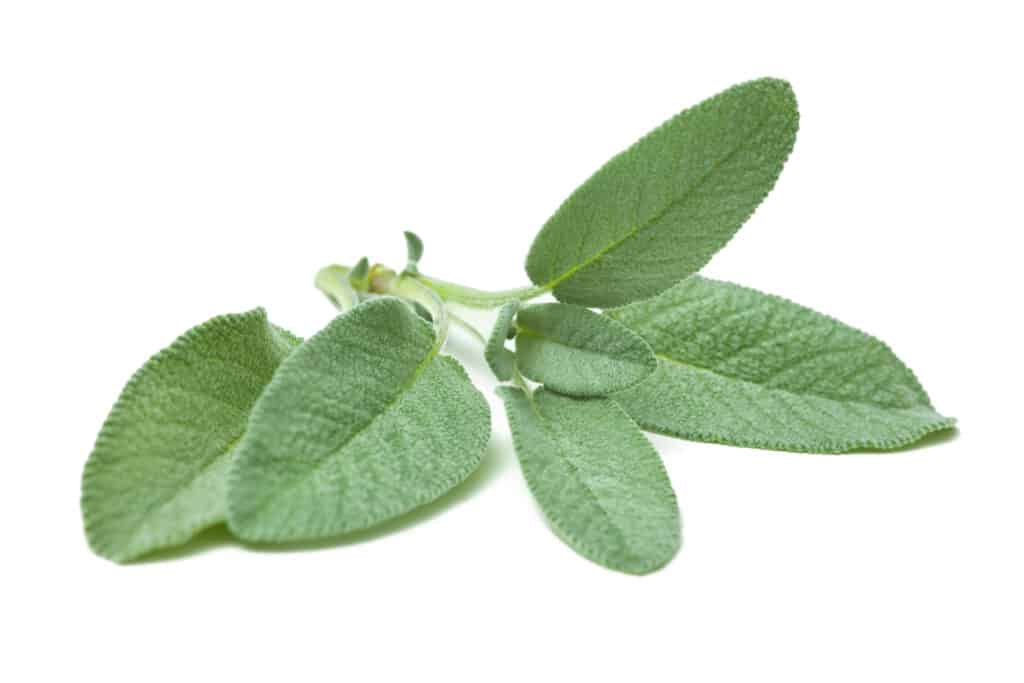We all want to keep our dogs safe, but we also want them to enjoy a treat now and then. It can be hard to know exactly what is and isn’t safe for your four-legged friend to eat.
We use several different herbs and spices in the meals we make, as well as in treats for our dogs. Is sage a safe herb to include in a dog’s diet? Yes, sage is safe for dogs. Learn more about sage and other herbs below.

Sage is a perennial in its native Mediterranean habitat.
©iStock.com/AlexRaths
What is Sage?
Sage (Salvia officinalis) is a member of the Lamiaceae family and native to the Mediterranean region. There are 236 genera and 7,000 species of Lamiaceae, including the mint family. We use common sage — or garden sage — in food such as stuffing, sausages, and other meats, as well as to add flavor to various soups and sauces.
Can Dogs Eat Sage?
Yes! Dogs can eat sage. According to the American Society for the Prevention of Cruelty to Animals, all parts of the sage plant — the leaves, stem, and flowers — are considered non-toxic to dogs. Still, limit your dog’s sage intake to only a few leaves a day.
Health Benefits of Sage for Dogs
Not only is sage safe for dogs, but it also has a few added benefits for your pup’s diet. These benefits include the following:
- Anti-inflammatory: Sage contains high levels of rosmarinic acid—a chemical compound believed to have natural anti-inflammatory properties and reduce seasonal allergy symptoms. Rosmarinic acid is named after rosemary, which also contains the natural chemical.
- Vitamins and Minerals: Sage contains various vitamins and minerals, including vitamin A, vitamin E, vitamin K, calcium, magnesium, potassium, phosphorus, and zinc. All of these are important for a dog’s healthy lifestyle!
- Antimicrobial: There are naturally antibacterial and antimicrobial properties in sage. These can help destroy harmful organisms that could lead to infection or fungal growth. For example: Sage kills bacteria that cause smelly breath, which means it’s a natural breath freshener.
What Herbs are Unsafe for Dogs?
While sage is an excellent addition to your dog’s bowl, there are several herbs and spices that should be avoided at all costs. Some toxic herbs for dogs include the following:
- Nutmeg: From a severe upset stomach to extensive nervous system damage, nutmeg can cause scary side effects if consumed by a dog.
- Onion: If your dog eats onion — both fresh or in dried powder form — it can cause diarrhea, vomiting, upset stomach, and even intense damage to red blood cells.
- Chamomile: Chamomile is highly toxic to dogs, and you want to avoid your dog’s contact with the actual plant. When consumed, chamomile can cause contact dermatitis, vomiting, diarrhea, anorexia, allergic reactions, and bleeding tendencies in dogs.
- Hops: Hops can be harmful, whether dried, fresh, or cooked. Consumption can cause panting, high body temperature, seizures, and even death in dogs.
- Garlic: If consumed in large amounts, garlic can cause dangerous symptoms in dogs, including drooling, nausea, oral irritation, vomiting, diarrhea, lethargy, abdominal pain, elevated heart rate and respiratory rate, weakness, exercise intolerance, collapse, and pale gums.

While sage smudging can greatly benefit humans, it can potentially harm dogs.
©Microgen/Shutterstock.com
Is Sage Smudging Safe for Dogs?
Burning sage is an ancient spiritual ritual many people partake in, usually to cleanse or purify a space. While smudging can greatly benefit humans (i.e., improving mood and cognition, repelling insects, and easing insomnia), it can harm our four-legged friends.
While sage is considered a non-toxic herb for pups and is safe for your dog to consume in their diet, burning it around your pup is not a good idea. A dog’s nose is far more sensitive to smell than a human’s nose, and overstimulation of sage smudging could damage their sense of smell.
If you decide to burn sage in your home, do so away from your dog and watch your pet for any potential reactions to the smell and smoke.
How to Feed Sage to Dogs Safely
Sage should be introduced into your dog’s diet slowly and in moderation. Large amounts of sage — and large amounts of most herbs — can cause vomiting, indigestion, or diarrhea.
Make sure to prepare the sage properly. Sprinkle a pinch of the dried herb into your dog’s food, but remember that a little goes a long way. Always monitor your dog for any side effects when incorporating any new ingredient into its diet.
There’s also no harm in checking with your veterinarian before giving your pup sage. Every dog is different and can have specific dietary restraints. It’s always better to be safe and consult a licensed professional first.
The photo featured at the top of this post is © iStock.com/Bonnie McCann
Ready to discover the top 10 cutest dog breeds in the entire world?
How about the fastest dogs, the largest dogs and those that are -- quite frankly -- just the kindest dogs on the planet? Each day, AZ Animals sends out lists just like this to our thousands of email subscribers. And the best part? It's FREE. Join today by entering your email below.
Thank you for reading! Have some feedback for us? Contact the AZ Animals editorial team.







